Due to its varied terrain and numerous habitats, Gangwon is one of the most ideal places for bird watching in South Korea. The region boasts various avian species, including raptors, waterfowl, shorebirds, and passerines.
Whether you’re a first-time birder or a seasoned pro, Gangwon has something to offer everyone. From the sandy beaches of the East Coast to the dense forests of the North, Gangwon is home to a rich diversity of birds.
From the majestic Red-crowned Crane to the colorful Azure-winged Magpie, Gangwon has something to offer every bird enthusiast. So come and explore the wonderful world of birds in Gangwon.
10 Birds to Watch in Gangwon
If you are a bird lover planning to visit South Korea, check out Gangwon province. Due to its varied terrain and numerous habitats, Gangwon is one of the most ideal places for bird watching in South Korea. The region boasts various avian species, including raptors, waterfowl, shorebirds, and passerines.
Here are 10 birds to watch in Gangwon that you don’t want to miss:
1. White-throated Needletail
The white-throated needletail is a species of swift that is part of the Hirundapus genus. It is believed to reach 170 km/h while in flight.
However, this belief has not been verified, as the methods used to measure the bird’s speed have not been made public. The white-throated needletail is also known as the needle-tailed swift or spine-tailed swift. It is a large swift, and its wingspan can span up to 16 inches.
This allows it to fly at incredible speeds and deftly maneuver in and out of tight spaces. The white-throated needletail is native to many parts of Asia, including India, Sri Lanka, Nepal, and China. It is also found in the Middle East and parts of Australia.
They tend to inhabit mountainous regions and are most active during the day when they feed on flying insects. Since the white-throated needletail is so swift, it isn’t easy to measure its speed accurately.
It has been suggested that it can reach speeds of up to 170 km/h, but this has not been officially verified.
The methods used to measure the bird’s speed have not been made public, so it is hard to say. Overall, the white-throated needletail is a fascinating bird with a remarkable ability to fly with great speed and agility.
While its exact speed is unknown, it is still admired for its impressive flight abilities.
| Kingdom | Animalia |
| Phylum | Chordata |
| Class | Aves |
| Clade | Strisores |
| Order | Apodiformes |
| Family | Apodidae |
| Genus | Hirundapus |
| Species | H. caudacutus |
2. Asian Stubtail
The Asian stubtail is a bird that belongs to the family Cettiidae. It was first described by Robert Swinhoe in 1863. This species of bird is native to Korea, Manchuria, and Japan. During the winter season, it migrates to southern China and northern Southeast Asia.
The Asian stubtail’s preferred habitat is temperate forests, which provide it with the necessary survival resources. Temperate forests are full of vegetation that serves as a food source and bird protection.
Moreover, the temperate climate ensures that the Asian stubtail is not exposed to extreme temperatures, which could harm its health. The bird also inhabits urban areas, such as parks and gardens.
This benefits the species by allowing them to feed on the vegetation and insects in these places.
All in all, the Asian stubtail is a species of bird that is adaptable to various habitats, and its range includes areas from Korea to Northern Southeast Asia.
| Kingdom | Animalia |
| Phylum | Chordata |
| Class | Aves |
| Order | Passeriformes |
| Family | Cettiidae |
| Genus | Urosphena |
| Species | U. squameiceps |
3. Large-billed Crow
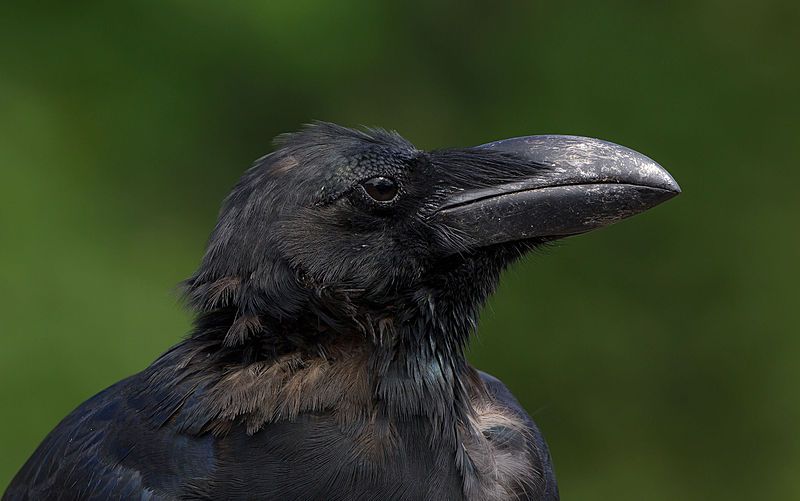
The large-billed crow, formerly referred to as the jungle crow, is a commonly found species of crow throughout Asia. This crow species is adaptable and can survive on a wide range of food sources.
This adaptability has allowed the large-billed crow to colonize new areas, leading to its reputation as a nuisance, especially on islands. The large-billed crow can easily find food in these areas, allowing them to expand their range.
This ability to quickly adapt to new areas has caused it to become a problem in many areas, as it can cause damage to crops and spread disease.
However, the large-billed crow also provides some benefits, as it is a food source for many other animals, and its large bill allows it to search for food in hard-to-reach places.
Overall, the large-billed crow is an important species with both positive and negative effects on its environment.
| Kingdom | Animalia |
| Phylum | Chordata |
| Class | Aves |
| Order | Passeriformes |
| Family | Corvidae |
| Genus | Corvus |
| Species | C. macrorhynchos |
4. Siberian Blue Robin
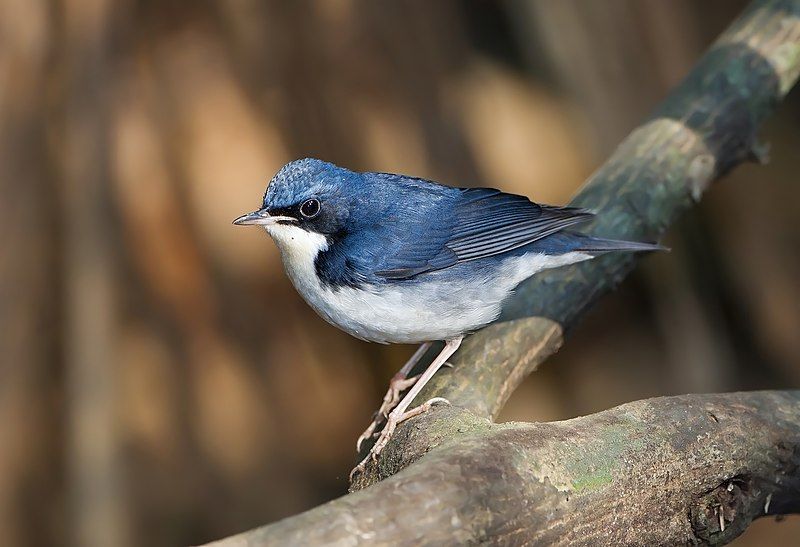
The Siberian blue robin is a small passerine bird found in Siberia. It was previously believed to be a member of the thrush family, Turdidae, but is now more generally accepted as belonging to the Old World flycatcher family, Muscicapidae.
It is a small species often referred to as a “chat” along with other small European species. The Siberian blue robin has distinctive blue feathers and is a common sight in the forests of Siberia.
This bird species is an essential part of the region’s ecology, playing a vital role in the food chain as both a predator and prey species and helping disperse various plants’ seeds.
As a result, it is essential to protect the habitat of the Siberian blue robin, ensuring that it is not overhunted or disrupted in any way.
| Kingdom | Animalia |
| Phylum | Chordata |
| Class | Aves |
| Order | Passeriformes |
| Family | Muscicapidae |
| Genus | Larvivora |
| Species | L. cyane |
5. Red-flanked Bluetail
The red-flanked bluetail is a small passerine bird found in the Old World. It was initially thought to be a part of the thrush family Turdidae. However, it is now classified as a member of the Old World flycatcher family, Muscicapidae.
This species, as well as other related species, is often referred to as chats. It is also known as the orange-flanked bush robin. The red-flanked bluetail is native to Eurasia and is found in various habitats, including woodlands, grasslands, and scrublands.
It is a small bird, measuring about 10-13cm in length. Its plumage has a blue back, grey wings, and a reddish patch on its flanks. It has a short bill and a distinctive white eye ring. Its diet consists mainly of insects but will also eat berries and other fruit.
The red-flanked bluetail is an active bird and can often be seen hopping around for food. It is usually seen alone or in pairs and is quite vocal, emitting various high-pitched chirps and trills.
During the breeding season, they can be found in open areas, where they build their nests in the shrubbery or on the ground. The female usually lays three to six eggs, which she incubates for about two weeks.
The chicks fledge after about two weeks and are ready to leave the nest within a month. The red-flanked bluetail is a beautiful bird that is enjoyed by birdwatchers around the world. Its vibrant colors and unique vocalizations make it a joy to observe.
With its increasing population, it is an integral part of the ecosystem, helping to keep insect populations in check.
| Kingdom | Animalia |
| Phylum | Chordata |
| Class | Aves |
| Order | Passeriformes |
| Family | Muscicapidae |
| Genus | Tarsiger |
| Species | T. cyanurus |
6. Long-tailed Tit
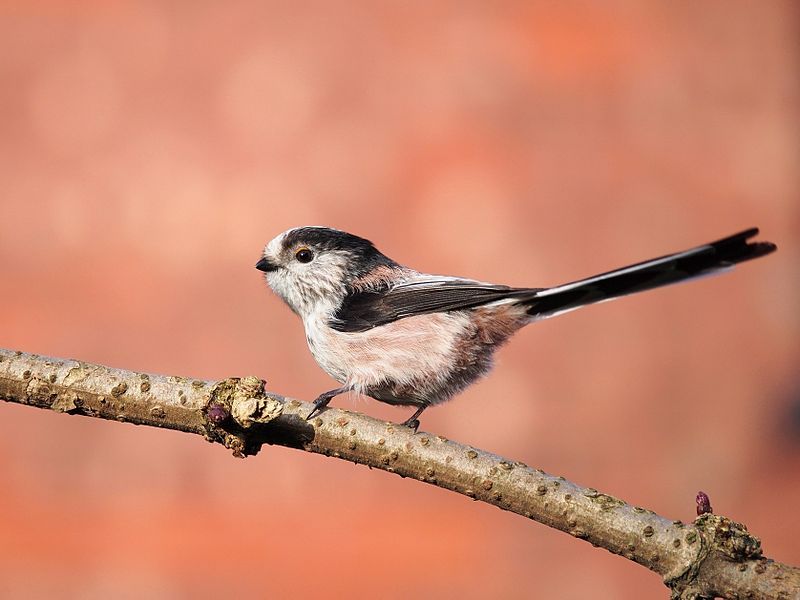
The long-tailed tit, also known as the long-tailed bushtit, is a species of bird found across Europe and the Palearctic region. It is a small bird known for its distinctive long tail feathers that can grow up to twice the length of its body.
Its scientific name, Aegithalos, was first used by Aristotle for some European tits, including the long-tailed tit. Long-tailed tits are social and gregarious birds, often seen in flocks of up to 40 individuals.
They are highly active and feed on insects, spiders, and small invertebrates. They build their nests from moss, lichen, and feathers, which they line with fur and wool.
These birds have adapted well to living in human-dominated habitats such as parks and gardens. The long-tailed tit is a valuable indicator species for its habitat, meaning that the presence of this species can be used to measure the health of an environment and the quality of its resources.
The long-tailed tit is also a popular subject for birdwatchers. Its attractive plumage and behavior make it a popular subject for observation and photography.
| Kingdom | Animalia |
| Phylum | Chordata |
| Class | Aves |
| Order | Passeriformes |
| Family | Aegithalidae |
| Genus | Aegithalos |
| Species | A. caudatus |
7. Pale Thrush
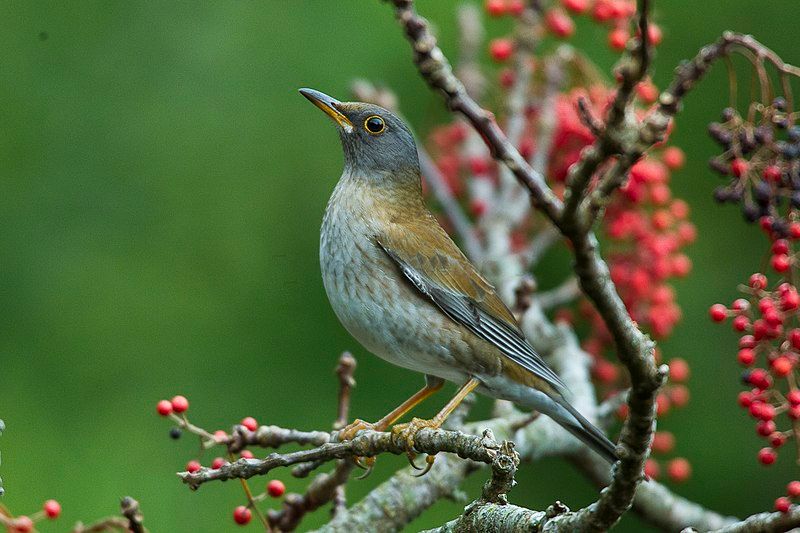
The pale thrush is a small bird found in the eastern Palearctic region, which is part of the continent of Eurasia.
It belongs to the genus Turdus and is part of the Turdidae family, which includes other species, such as the eye-browed thrush and the grey-backed thrush.
This species of thrush is about 23 cm long and has pale pinkish-brown feet, aa grey upper bill,, and a yellow lower bill. The pale thrush has a brownish-grey back, wings, and white underside.
Its wings have a distinctive white patch, and its tail is black with white edges. Its head is also brownish-grey, with a white eye-ring and a black line running through it.
The pale thrush is a common species and can usually be found in open woodlands, scrub, gardens, and farmland.
Its diet consists mainly of insects but will also feed on berries, flowers, and other plant material. The pale thrush is an essential species in its native range, as it helps to keep the local insect population in check.
It is also an important pollinator, as it visits flowers for nectar. The pale thrush is widespread among birdwatchers, as it is relatively easy to spot and has a pleasant song.
This species is not considered to be threatened at present, but its population may decline in the future due to habitat loss and degradation.
| Kingdom | Animalia |
| Phylum | Chordata |
| Class | Aves |
| Order | Passeriformes |
| Family | Turdidae |
| Genus | Turdus |
| Species | T. pallidus |
8. Pale-legged Leaf Warbler
The Pale-legged Leaf Warbler is a species of bird belonging to the Old World warbler family, Phylloscopidae. It was first described by Robert Swinhoe in 1860. This species can be found in the Manchurian region and migrates to Southeast Asia for wintertime.
Its natural habitat consists of temperate forests providing the ideal life conditions. These forests are mostly found in mountainous regions and contain a variety of trees, shrubs, and plant life.
The Pale-legged Leaf Warbler will often flock in groups and feed on insects, small fruits, and other small items in the environment. This warbler species is highly adapted to living in these temperate forests and can be found easily in its natural habitat.
| Kingdom | Animalia |
| Phylum | Chordata |
| Class | Aves |
| Order | Passeriformes |
| Family | Phylloscopidae |
| Genus | Phylloscopus |
| Species | P. tenellipes |
9. Japanese Pygmy Woodpecker
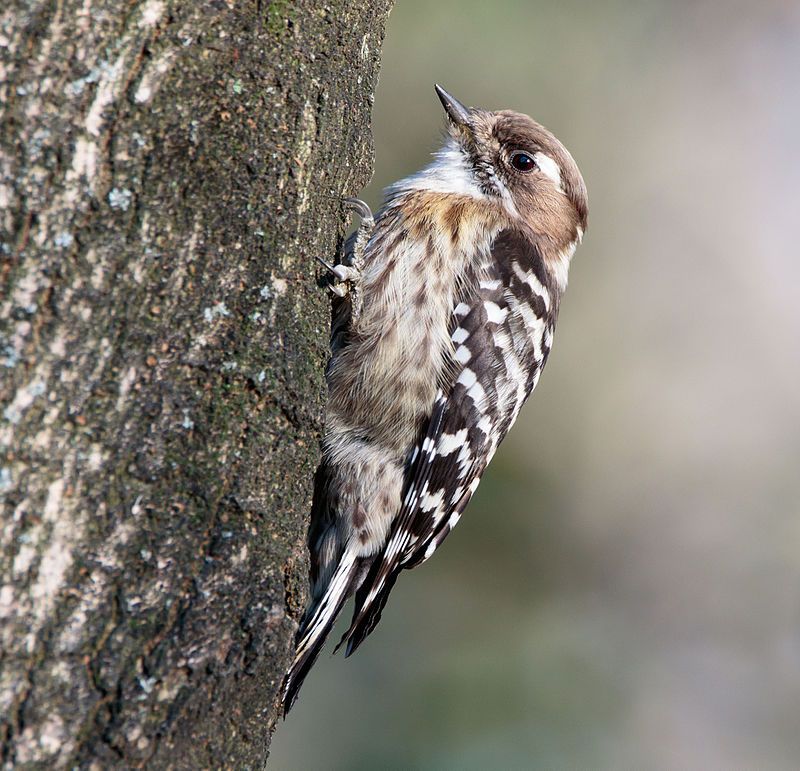
The Japanese Pygmy Woodpecker is a species of woodpecker that is found in various parts of Asia. It is native to Russia, China, Korea, and Japan and is commonly found in coniferous and deciduous forests.
This species has been placed in two different genera, Dendrocopos and Picoides. It is a small bird with a black head and a white throat. It has a short, straight bill and a bright red crown. The wings and tail are barred with black and white, and it has a brownish-red back.
The Japanese Pygmy Woodpecker feeds mainly on insects and eats berries and other small fruits. It nests in tree cavities and is a solitary species. It is an integral part of the ecosystem, as it helps to disperse seeds and control insect populations.
| Kingdom | Animalia |
| Phylum | Chordata |
| Class | Aves |
| Order | Piciformes |
| Family | Picidae |
| Genus | Yungipicus |
| Species | Y. kizuki |
10. Marsh Tit
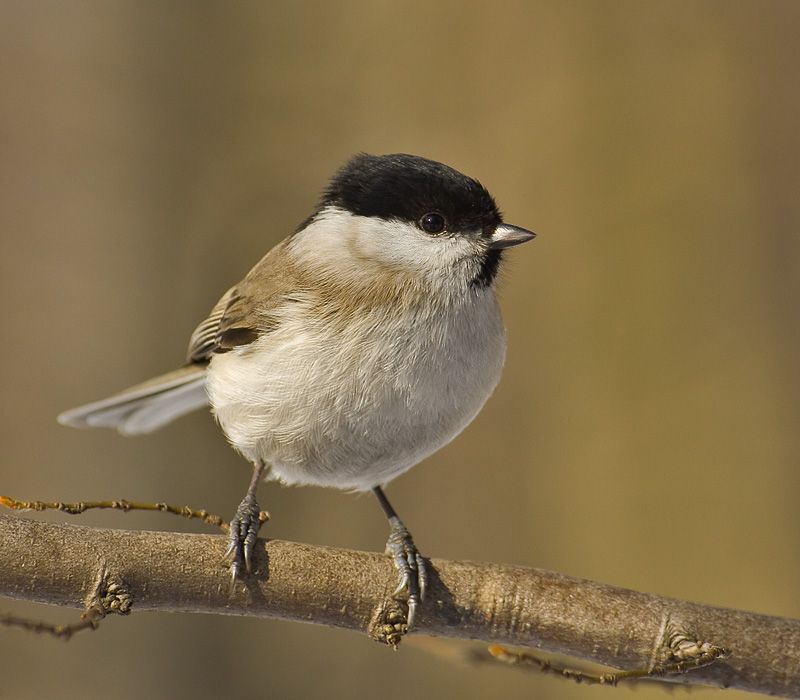
The marsh tit is a small bird that is part of the family Paridae and the genus Poecile. It measures about 12 cm in length and weighs around 12 grams. It has a black crown, nape, pale cheeks, brown back, and greyish-brown wings and tail.
It is closely related to the willow tit, Père David’s tit, and Songar tit. The marsh tit is a passerine bird, meaning it has a body shape adapted for perching. It has a strong, curved bill helps it catch insects, seeds, and other food items from branches and other surfaces.
Its wings are adapted for fast, sustained flight, enabling it to migrate to warmer climates in the winter. The marsh tit’s tail is long, helping it to balance while perched. The marsh tit is usually found in marshy or wet woodlands.
It feeds on insects such as beetles, flies, caterpillars, seeds, nuts, and fruits. It often visits bird feeders and takes food from the ground or trees. It is a social species seen in small groups or as part of a larger flock.
The marsh tit is an essential species in forest ecosystems, helping to control insect populations and dispersing seeds and other fruit. However, its populations are in decline due to habitat loss and fragmentation.
It is essential to protect and conserve wetlands and woodlands to ensure the long-term survival of this species.
| Kingdom | Animalia |
| Phylum | Chordata |
| Class | Aves |
| Order | Passeriformes |
| Family | Paridae |
| Genus | Poecile |
| Species | P. palustris |
Conclusion
Gangwon is home to a wide variety of bird species. These birds provide a refuge for many migratory birds traveling through the region yearly.
The presence of these birds is a testament to the importance of preserving the unique ecosystems of Gangwon. These birds are also an integral part of the region’s vibrant culture, providing many opportunities for bird-watching and other outdoor activities.
With the proper conservation measures, Gangwon can continue to provide a haven for these birds and other wildlife species for generations to come.